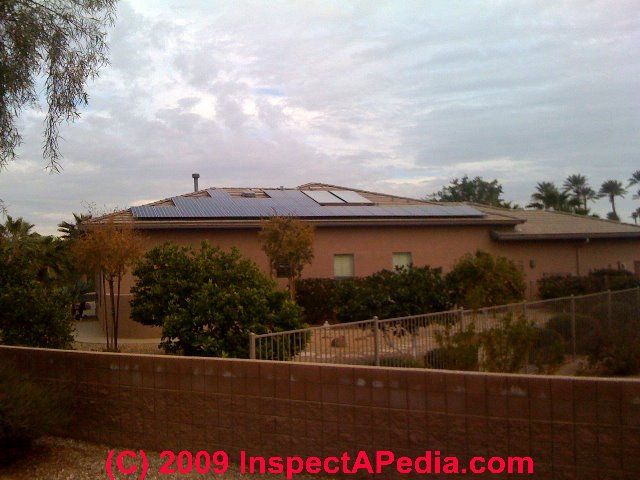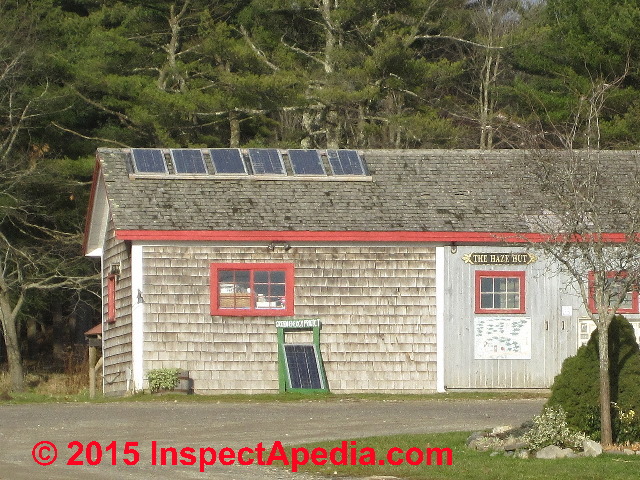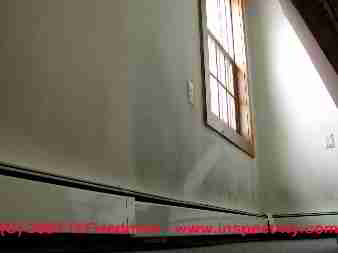 Balance Energy Expenditures for Maximum Return on Investment
Balance Energy Expenditures for Maximum Return on Investment
- POST a QUESTION or COMMENT about how to prioritize spending on saving energy in buildings: priorities in reducing electricity bills, heating bills, cooling bills
How to save the most home heating or cooling energy for the least retrofit cost:
This article explains the basic priorities of steps to take in reducing building heating or cooling costs to obtain the maximum economic return when installing solar heating systems.
InspectAPedia tolerates no conflicts of interest. We have no relationship with advertisers, products, or services discussed at this website.
- Daniel Friedman, Publisher/Editor/Author - See WHO ARE WE?
How to Maximize the Return on Energy Savings Retrofits & Solar Energy Systems
Balancing Act - how to get the most return on energy efficiency investments
[Click to enlarge any image]
Our photo (above left) shows a building insulation retrofit project in process where the owner was removing the original brick wall lining to install building insulation. Details of that project are at BRICK LINED WALLS.
Compare BTU/hour value for old leaky wood frame house vs. adding Solar Energy System
I understand the importance of insulating a house before installing any solar space heating system.
See INSULATION LOCATION - WHERE TO PUT IT.
How low a Btu/hour value should I attain in a 60-year old, leaky, wood frame house before solarizing?
The house is 1900 square feet, has oil / hot water heat, and is located in Maryland (4000 heating degree days).
Also, how should the basement be insulated - around its perimeter or under the first floor?- reader question
Answer:
Above: photovoltaic panels on a Maine rooftop.
See PHOTOVOLTAIC POWER SYSTEMS for details.
If you want to get the largest return on your investment in building energy efficiency, you should balance your expenditures on
- energy conservation
- solar energy
- auxiliary equipment
so that your economic return is equal for each.
Whatever analysis you use to make economic decisions
- Simple payback calculation on energy savings projects - how many years until the energy savings pays back the cost of the energy improvement
- Life-cycle costing calculation on energy savings projects - adds consideration of the costs of maintenance, repair, replacement of the energy improvement
- Return on investment calculation on energy savings projects - adds consideration of the alternative rate of return if the money spent on energy improvement were invested elsewhere
you should apply the method fairly to each part of the house. How much you want to spend in total will depend on what return on your money you find acceptable.
Law of Diminishing Returns on Energy Savings Investments
Above: thermal tracking on the surface of an exterior wall can indicate areas of building heat loss.
See THERMAL TRACKING REMEDIES for details.
In general, the first dollars invested in energy savings will bring larger returns than later dollars due to the law of diminishing returns.
See ENERGY SAVINGS PRIORITIES for details.
To be fair, you should apply your cost accounting only to the energy cost of a building part, if it serves another function (for example a window decoration, structure, or added living space).
In the case of an upgraded heating system, you should consider the added cost over the conventional equipment that you would otherwise install. There is a good deal of fudging and judgment in all this and plenty of room for common sense.
Placement of Basement Insulation
As for basement insulation, either approach will work. Of course, if you want a heated basement you should insulate the perimeter. Also, if you insulate the floor above the basement, you increase the risk of freezing pipes in the basement.
If the basement is mostly below grade and has no leaky doors and windows, this shouldn't be a problem in your climate.
See INSULATION LOCATION for BASEMENT for detailed suggestions about basement insulation.
Also see INSULATION LOCATION - WHERE TO PUT IT.
The question-and-answer article about energy savings investment strategy when adding solar heat, quotes-from, updates, and comments an original article from Solar Age Magazine and written by Steven Bliss.
Original article
The link to the original Q&A article in PDF form immediately below is preceded above by an expanded/updated online version of this article.
- Q&A on Balancing Act [PDF] how to get the largest return on investment in energy efficiency - PDF version, Use your browser's back button to return to this page
The question-and-answer article below paraphrases, quotes-from, updates, and comments an original article from Solar Age Magazine and written by Steven Bliss.
Our page top photograph shows solar panels, both photovoltaic and domestic hot water heating systems, on a rooftop in Surprise, Arizona. The accompanying text is reprinted/adapted/excerpted with permission from Solar Age Magazine - editor Steven Bliss.
...
Continue reading at ENERGY SAVINGS PRIORITIES or select a topic from the closely-related articles below, or see the complete ARTICLE INDEX.
Or see these
Recommended Articles
Suggested citation for this web page
ENERGY SAVINGS MAXIMIZE RETURNS ON at InspectApedia.com - online encyclopedia of building & environmental inspection, testing, diagnosis, repair, & problem prevention advice.
Or see this
INDEX to RELATED ARTICLES: ARTICLE INDEX to BUILDING ENERGY SAVINGS
Or use the SEARCH BOX found below to Ask a Question or Search InspectApedia
Ask a Question or Search InspectApedia
Try the search box just below, or if you prefer, post a question or comment in the Comments box below and we will respond promptly.
Search the InspectApedia website
Note: appearance of your Comment below may be delayed: if your comment contains an image, photograph, web link, or text that looks to the software as if it might be a web link, your posting will appear after it has been approved by a moderator. Apologies for the delay.
Only one image can be added per comment but you can post as many comments, and therefore images, as you like.
You will not receive a notification when a response to your question has been posted.
Please bookmark this page to make it easy for you to check back for our response.
IF above you see "Comment Form is loading comments..." then COMMENT BOX - countable.ca / bawkbox.com IS NOT WORKING.
In any case you are welcome to send an email directly to us at InspectApedia.com at editor@inspectApedia.com
We'll reply to you directly. Please help us help you by noting, in your email, the URL of the InspectApedia page where you wanted to comment.
Citations & References
In addition to any citations in the article above, a full list is available on request.
- Solar Age Magazine was the official publication of the American Solar Energy Society. The contemporary solar energy magazine associated with the Society is Solar Today. "Established in 1954, the nonprofit American Solar Energy Society (ASES) is the nation's leading association of solar professionals & advocates. Our mission is to inspire an era of energy innovation and speed the transition to a sustainable energy economy. We advance education, research and policy. Leading for more than 50 years. ASES leads national efforts to increase the use of solar energy, energy efficiency and other sustainable technologies in the U.S. We publish the award-winning SOLAR TODAY magazine, organize and present the ASES National Solar Conference and lead the ASES National Solar Tour – the largest grassroots solar event in the world."
- Steve Bliss's Building Advisor at buildingadvisor.com helps homeowners & contractors plan & complete successful building & remodeling projects: buying land, site work, building design, cost estimating, materials & components, & project management through complete construction. Email: info@buildingadvisor.com
Steven Bliss served as editorial director and co-publisher of The Journal of Light Construction for 16 years and previously as building technology editor for Progressive Builder and Solar Age magazines. He worked in the building trades as a carpenter and design/build contractor for more than ten years and holds a masters degree from the Harvard Graduate School of Education. Excerpts from his recent book, Best Practices Guide to Residential Construction, Wiley (November 18, 2005) ISBN-10: 0471648361, ISBN-13: 978-0471648369, appear throughout this website, with permission and courtesy of Wiley & Sons. Best Practices Guide is available from the publisher, J. Wiley & Sons, and also at Amazon.com - In addition to citations & references found in this article, see the research citations given at the end of the related articles found at our suggested
CONTINUE READING or RECOMMENDED ARTICLES.
- Carson, Dunlop & Associates Ltd., 120 Carlton Street Suite 407, Toronto ON M5A 4K2. Tel: (416) 964-9415 1-800-268-7070 Email: info@carsondunlop.com. Alan Carson is a past president of ASHI, the American Society of Home Inspectors.
Thanks to Alan Carson and Bob Dunlop, for permission for InspectAPedia to use text excerpts from The HOME REFERENCE BOOK - the Encyclopedia of Homes and to use illustrations from The ILLUSTRATED HOME .
Carson Dunlop Associates provides extensive home inspection education and report writing material. In gratitude we provide links to tsome Carson Dunlop Associates products and services.



